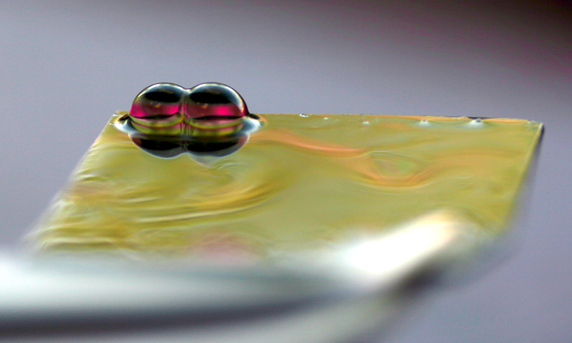The ability to pull water out of fog is just one of many possibilities made real by research involving assistant professor Andy Sarles of the College of Engineering’s Department of Mechanical, Aerospace and Biomedical Engineering at the University of Tennessee, Knoxville.
The project Sarles took part in—Air-stable Droplet Interface Bilayers on Oil-infused Surfaces—was published recently in the Proceedings of the National Academy of Sciences.
In short, what the team, made up of Sarles and scientists from Oak Ridge National Laboratory’s Center for Nanophase Material Sciences and the ORNL Energy and Transportation Science Division, uncovered was that water droplets placed on oil-infused surfaces formed stable, interconnected volumes without fusing into increasingly larger droplets.
Creating networks of these connected droplets is key to future breakthroughs.
While the physics of droplets on an oil-coated surface shows the promise of pulling water from fog, the ability to form air-stable lipid membranes will allow researchers to do everything from detecting airborne species like chemical or biological toxins, pollutants or synthetic nanoparticles, as well as converting energy using biological molecules contained in the membrane.
Related: Read PNAS article on the work of Sarles and his fellow researchers at http://www.pnas.org/content/early/2014/05/08/1400381111.abstract
 “The first goal of this work was to understand the mechanisms that allow for droplets to remain as separate entities on the oil-coated surfaces,” said Sarles. “After that, we want to apply those principles to a variety of sensing, energy conversion and even protein study applications.”
“The first goal of this work was to understand the mechanisms that allow for droplets to remain as separate entities on the oil-coated surfaces,” said Sarles. “After that, we want to apply those principles to a variety of sensing, energy conversion and even protein study applications.”Along with this discovery came the awareness of how to create artificial cell membranes—called lipid bilayers—between droplets in air.
Previous work had established that when water droplets submerged in oil collided the oil between the droplets would be excluded, allowing the droplets to coalesce in just seconds.
But by placing droplets on an oil-coated, superhydrophobic surface rather than submerging them, Sarles and the team showed that droplets would spontaneously join together and yet not coalesce when they collided. Instead, a thin layer of oil was wicked between the adjoined droplets, making a stable connection that lasted for up to days at a time.
“I measured the thicknesses of oil films that spontaneously assembled between colliding droplets,” said Sarles. “I pierced them with thin electrodes so that I could monitor how well electrical charge was stored at the interface between droplets, which allowed us to estimate the thickness of the oil film over time as the oil slowly drained.”
And while this thin layer of oil does eventually drain out—leading to coalescence—Sarles and the team showed that the fluid physics that caused the droplets to draw together could also be used to assemble artificial cell membranes.
This breakthrough enabled the team to extend the lifetime of the interface between droplets and marks the first time that droplet interface bilayers were formed in air.
For more on the College of Engineering, visit http://engr.utk.edu.
Written By: David Goddard
